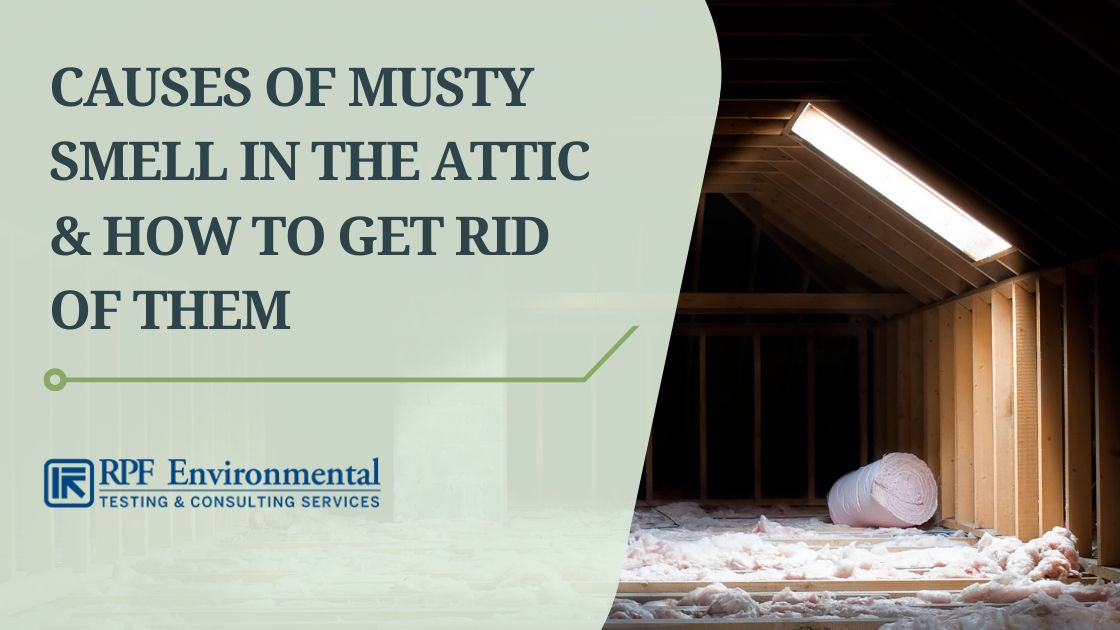Improper ventilation is often the root cause of a musty smell in the attic which leads to more serious problems like increased moisture. This, in turn, results in the growth of mold and mildew as well as wet insulation which will cause a damp, musty smell. Thus, improving attic ventilation and fixing moisture issues are the most effective solutions in solving the issue.
So if your attic smells musty and you want to know more about what’s causing it and how to get rid of the problem, read on!

RPF Environmental can help you identify the cause of the musty smell from your attic through our professional indoor air quality testing services. We serve areas in New Hampshire, Maine, Massachusetts, and beyond New England. Contact us now!
5 Causes of a Musty Smell in Your Attic
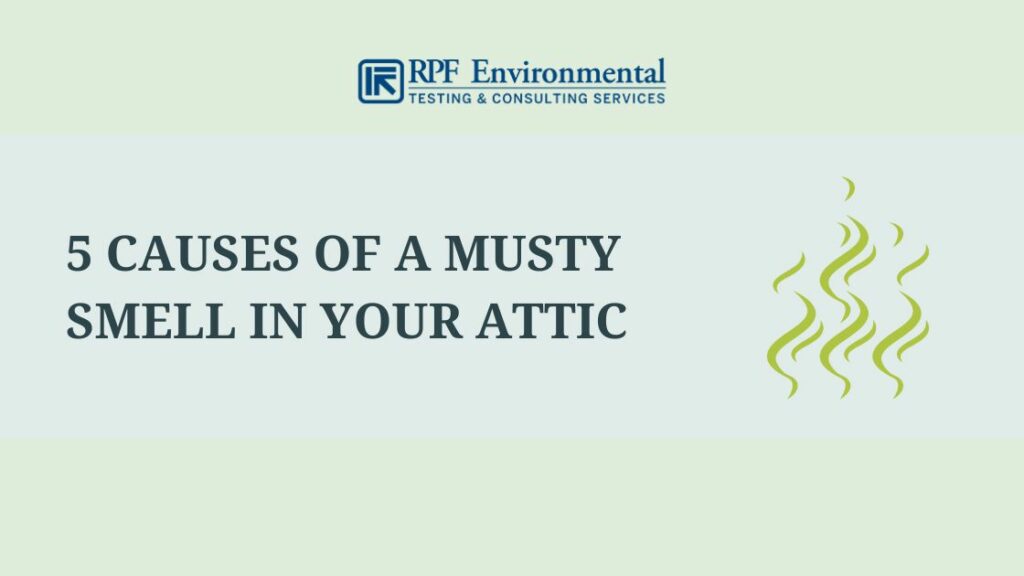
Below are the top five possible causes if you smell something unpleasant from your attic:
1. Poor Ventilation & Improper Venting
Attics with poor ventilation can cause condensation by trapping humid air from improperly vented exhausts in your home. Attic condensation is also common during the spring and winter months when you heat your home. The hot, moist air from the heated parts of your house rises into your attic space, meets your cold roof, and then condenses into liquid.
2. Leakages in the Roof
Broken pipes and a leaking roof might also be causing a musty attic smell. Frost is not a problem in the winter. But once it melts, it will cause more serious problems like mold growth and wood rot.
3. Mold and Mildew Growth
Attics are among the most common areas where mold and mildew can grow because they create a perfect environment for mold to thrive. They are dark, humid, and abundant in food sources (organic matter). But then again, poor ventilation which creates condensation and increases moisture levels is what causes mold to grow.
Once mold starts growing in your attic, it can spread throughout other areas and cause serious health issues and more damage. Aside from mold infestation, condensation can also damage your roofing and shingles which will lead to bigger problems.
Also Read: 17 Common Places Where You Can Find Mold in Your Home
4. Wet or Poor Insulation
Poor insulation and condensation, along with other causes of excessive moisture like leaks, can impact your attic insulation’s effectiveness when it gets damp. It will reduce the insulation’s energy efficiency and can cause your energy bills to rise. Aside from that, damp insulation can cause mold to grow which will lead to a musty smell.
NOTE: Certain types of insulation, specifically cellulose loose-fill insulation, are more prone to mold and mildew because they provide an ideal breeding environment.
Related Question: Could old attic insulation be part of the “old house smell”?
Yes, old attic insulation can contribute to an “old house smell”. Aside from mold, it can harbor dead animals and rat nests which will lead to the pungent smell of rat feces and urine.
5. Dead Animals
Animals like rats, mice, or birds can get trapped and die in your attic, creating a sulfur-like odor. The feces and urine of rodents that have inhabited your attic for a long time can also cause a foul smell. This, in turn, can attract other insects and worsen the issue.
Signs of Moisture in the Attic
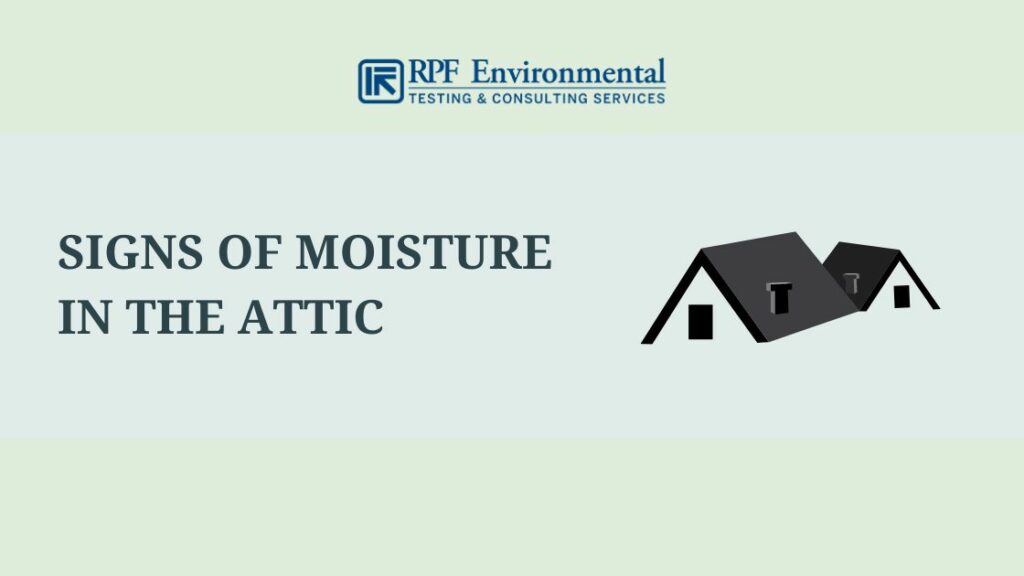
In relation to the musty smell, below are signs of moisture issues in your attic that can lead to unpleasant smells later on:
- Rusty or damp nails
- Foggy windows
- Moisture on surfaces
- Visible mold
- Rotting or damp wood
- Dark stains
- Watermarks on walls, ceilings, or floors
- Warping and discoloration in construction materials (e.g buckled roof sheathing)
5 Methods on How to Get Rid of the Musty Smell in the Attic
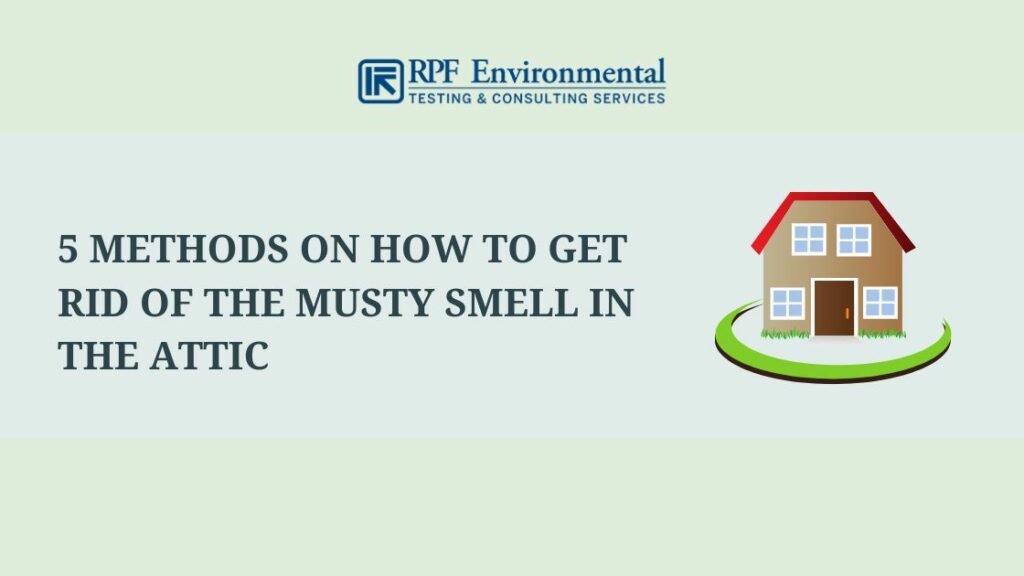
Aside from causing health complications, moisture issues including mold infestation in your attic can lower your home’s value if you are planning to sell it. So if you want to keep your family safe and attract potential buyers, you need to get them fixed.
First Step: Identify the Source of the Musty Attic Smell
Finding out the source of the musty odor in your attic is your first step in getting rid of it. By finding the root cause, you will be able to eliminate it completely from your home.
Method 1. Reduce Excess Moisture
Manage sources of moisture in your home by following these tips:
- Don’t use humidifiers in well-insulated areas because they will only create excess moisture
- Check roof leaks and leaking pipes and fix them
- Vent heaters and exhaust fans outdoors and not into your attic or crawl spaces
- Improve ventilation in your attic (more in the next section)
Method 2. Improving Attic Ventilation
Increase airflow in your attic to prevent condensation and moisture issues as well as save on energy costs by doing the following:
- Check for clogged ductwork that might be blocking airflow
- Ensure that nothing is blocking your vents
- Reroute dryer and bathroom vents outside if they are vented into your attic
- Install roof vents
- Use fans to draw air out of your attic
Method 3. Fix Leakages
Inspect your vents for any damage that might be causing warm air to leak into your attic. Seal any entry points like cracks and roof leaks. Better yet, call a professional roofing repair company to inspect your roof.
Method 4. Replace Wet Insulation
Wet insulation means it is possibly infested by mold and you need to replace the affected parts or even the entire insulation. For worse mold infestations, contact a mold testing company to accurately identify the source and ensure complete removal.
Dying Out Wet Attic Insulation
You can dry out the insulation if it’s not too wet. But oftentimes, replacement is the only solution. For instance, cellulose loose-fill insulation consists of plant fibers that can easily absorb moisture so it won’t be easy to dry it out. For fiberglass batts that are not too drenched, you can dry them out using fans. You can also remove the batts and put them under direct sunlight if using fans won’t work.
Method 5. Deep Cleaning
The last method would be to perform a deep cleaning in your attic. You can follow the basic steps below:
- Wear protective clothing.
- Locate dead animals and remove them.
- Clear out any clutter or debris.
- Vacuum and sweep your attic.
- Look for signs of mold infestation.
- Clean and disinfect your attic using a soapy solution to kill any bacteria.
- Spray white vinegar onto molds and let it sit for one hour.
- Spray a baking soda solution onto stubborn mold stains and scrub them off with a brush. Wipe the area with a damp, clean cloth after scrubbing.
- Run fans in your attic for several hours to circulate the air and allow it to dry faster.
Signs Indicating the Need for Attic Cleanup
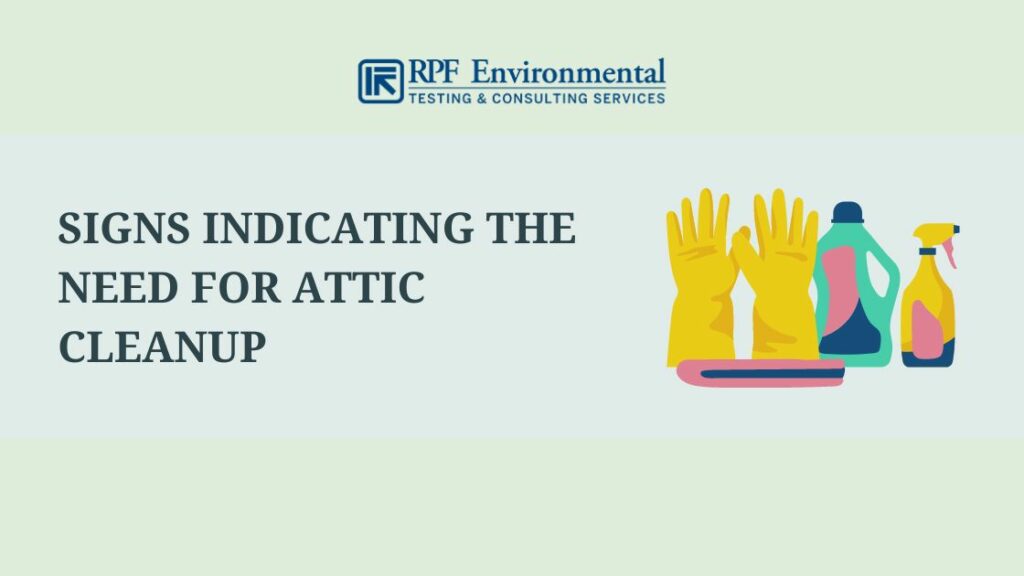
Lastly, below are a few signs that you need to clean your attic as soon as possible:
1. Allergies & Respiratory Issues
If you or your family are experiencing allergies and/or respiratory issues, it might be caused by hidden mold in your attic. Aside from mold allergy, immunocompromised individuals exposed to mold can develop more severe reactions and lung infections. Before the problem gets worse, have your attic inspected for mold. Hire a mold remediation company if needed to deal with large infestations.
2. Rising Energy Bills
Wet or damaged insulation will reduce energy efficiency because it will become less effective at minimizing heat flow. This will lead to higher-than-normal electricity bills. So if you want to save on your utility costs, it’s time to fix problems in your attic.
Also Read: How Much Does an Indoor Air Quality Testing Cost?
FAQs
You need to identify what’s causing the musty smell first before you can get rid of it. It may be dead animals, feces and urine of rodents that have infested your attic, leakages, mold infestation, and others. Since moisture is the root cause of many other issues leading to a musty attic smell, improving ventilation and fixing leaks are the best solutions.
Although there is a high chance that you’re dealing with mold if you notice a musty smell from your attic, it’s not always the case. It can also be pet odors, rodent issues, or HVAC problems.
Mold in the attic can smell musty, earthy, sour, smells like wet socks or rotten meat, and others. The smell will vary depending on the type of mold, its growth stage, and food sources. You can read more on our blog about What Mold in the House Smells Like.
Conclusion
A musty smell in your attic is often caused by moisture issues due to poor ventilation which can lead to more serious problems like mold infestation. It can also be caused by dead animals and roof leaks. If you need help with identifying what’s causing the musty smell, call a professional indoor air quality inspector or mold inspection company.
RPF Environmental offers indoor air quality testing and mold inspection services in New Hampshire, Massachusetts, Maine, and other areas in the United States. We provide affordable solutions tailored to your needs. Contact us now!

